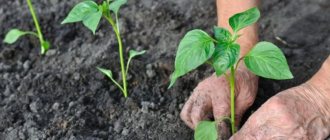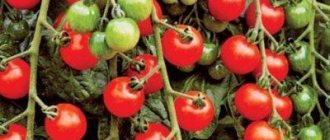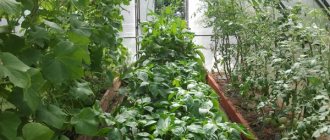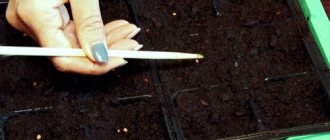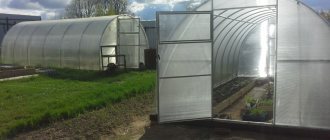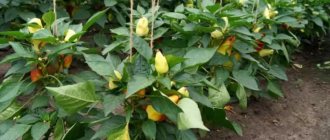Pepper is very popular in our country and is grown in all regions. However, not everywhere they can be grown in open ground due to cold conditions. Therefore, it is recommended to use polycarbonate greenhouses for their cultivation. In addition to creating good conditions for your plant, you can also speed up the harvest. However, in order to get a good harvest of tasty and juicy peppers, it is important to devote time to them and properly care for them. Which pepper planting suits you best - read more in this article.
Planting peppers in a polycarbonate greenhouse - placement rules
pepper planting
When planting peppers in beds, it is very important to pay attention to the placement and distance between seedlings. By following all the rules, you can not only get a large harvest of good quality, but also speed up the ripening of pepper, and therefore its harvesting.
There are many rules for planting, but it makes no sense to compare which is better, since they depend on the varieties and climatic conditions in which they will grow.
If peppers are planted in a polycarbonate greenhouse, then the width of the beds will depend on the structures installed in it. Width is of great importance when growing this crop, influencing the volume of the harvest.
For example, in a three-meter greenhouse you can place two or three beds from 70 centimeters to one meter.
So, let's look at the rules for planting bell peppers. There are several planting rules, but most often, especially novice gardeners, adhere to the classic planting method.
To do this, prepare holes in advance, where the distances from each other will be at least 20 centimeters, and the distance between the rows will be about 50 centimeters.
However, those gardeners who have been growing this vegetable for a long time also have more effective planting schemes in their arsenal.
One of the methods is wide-row. Using this method for planting, it is necessary to make holes at a distance of 60 centimeters between the rows and from each other from 15 to 30 centimeters.
The second method, which is used to get a good harvest, is a two-line or three-line tape.
Between such tapes the distances are 60 centimeters; in the tape between rows there should be 20 to 40 centimeters and from 15 to 30 centimeters there should be distances between plants in a row.
The third method is square-nested. In this case, the roots of the plant are planted 2 pieces in one nest and a distance of 60 centimeters is maintained.
The fourth method is chess. In this case, nests for seedlings are made like on a chessboard; it is important to follow the placement rules of 20x20, 30x30 is also possible.
Using this method, you can significantly save space for planting without depriving your plants of comfort.
There is also a method where 3 plant roots are planted in one hole. However, this method is only suitable for the southern regions of our country.
Since, due to the thickening that is created during such planting, the pepper begins to need more sun during the entire growth period.
When choosing this method of planting, you need to know that it makes caring for the crop much more difficult and increases the risk of fungal infections.
Remember that when choosing planting methods in which several plants are placed in one hole, you will need to use twice as much fertilizer.
Harvesting
You can harvest peppers when they reach maturity:
- biological;
- technical.
Biological maturity is the achievement of full ripeness by the fruit, which requires rapid processing, since this vegetable crop has a fairly short fresh shelf life (no more than 14 days). Depending on the variety of sweet pepper, ripeness is distinguished by color: yellow, orange, red, brown and purple. As soon as the fruit has reached maturity, it must be picked and, within an acceptable time, either realized (sold), eaten, or processed.
Technical maturity is slightly unripe fruits, which then “reach” after being picked from the bush. A harvest of technical maturity is harvested if it needs to be transported over long distances or stored for a long time (60 days or more).
The first fruits are harvested in August, the last in November. Peppers are trimmed with the stalk, which is necessary for better preservation of all its beneficial substances and a longer shelf life.
In general, greenhouse plantings of peppers yield up to 4 harvests per season.
Permissible number of plants when planting in one hole
pepper planting
By planting plants densely, you can get larger fruits than those that were kept at a greater distance between them. This is due to the fact that temperature changes occur more evenly.
But due to the fact that with this method the plant receives less sun and carbon dioxide, the ripening time is greatly increased. Therefore, this method is best used by those who live in the south of Russia.
To compensate for carbon loss, organic fertilizers can be used. With this method of feeding, you can safely plant 1 square meter. meter 14 plants.
If you do not plan to fertilize the soil in the greenhouse with organic matter, plant 1 square meter. There should not be more than 8 bushes.
Diseases
A thorough analysis of the greenhouse microclimate and an external inspection will help you find out why peppers grow poorly in a greenhouse and why they turn yellow. Most often, fungi and infections affect plants that are in a poorly ventilated area or flooded with water.
The main diseases of peppers are:
- Mosaic. Leaves lose transpiration and yields decrease.
- White rot. Plaque forms on the root part, the death of seedlings occurs in 3-4 days. The reason is high humidity, rare ventilation of the greenhouse.
- Late blight. Holes appear on the leaves, dark purple spots on the fruits and crown. The culprit is considered to be a cold snap at night and excess moisture.
- Black spot. The leaves and peppercorns become covered with tubercles, which turn black, causing the death of the plant.
They fight infections by sprinkling the damaged areas with charcoal or chalk. It is important to establish an irrigation regime and constantly maintain a comfortable atmosphere inside the greenhouse. Immediately remove diseased bushes away from healthy ones, and don’t hesitate to throw them away. This will help keep yields high.
Planting pepper seedlings in a greenhouse
When transplanting peppers, it is important to follow some rules for the good development and growth of the plant. How quickly your seedlings will take root depends on how you act.
Preparing nests for planting and planting seedlings should be carried out as follows:
Mark the area to create rows and nests using a marker or any tape. Nests are made to a depth of no more than 15 centimeters; peppers do not like to be placed too deep. The distance between them along the row should be from 15 to 30 centimeters.
After the holes are ready, they need to be fertilized. To do this, add a mixture made from 200 grams of humus, 1 tablespoon of phosphate and a spoon of wood ash. Next, each nest should be watered with one liter of warm water.
By adding Fitosporin solution to the water, you will prevent many bacterial and fungal infections. Immediately after you have fertilized and watered the holes, you need to plant your plants. The roots must be pressed firmly, but gently, so as not to damage them, with soil.
This way, each root can receive the necessary amount of nutrients and moisture, which will help them function well and adapt faster. Nests with plants planted in them must be filled with a mixture of dry soil and compost.
Such a mound will allow the plant to receive more oxygen and help it take root faster. Seedlings that have an open root system and are grown in large containers should be planted when the sun has already set.
Since it is very difficult for pepper seedlings to take root, they should be given help. This can be done during repeated watering by adding growth stimulants with a complex of microelements, phosphorus, potassium and nitrogen to the water.
They have a positive effect on plants, helping them survive stress faster and easier and stimulating root development. You can purchase such fertilizers in a specialized store.
It must be used in accordance with the information specified in the instructions.
Top dressing
Many gardeners wonder what to feed peppers after planting in a greenhouse and during the period of active growth of the bush. There are several stages of introducing fertilizers:
- 3-4 weeks after planting the seedlings in the greenhouse. Superphosphate 5 grams mixed with water 10 liters and urea 10 grams is suitable. Pour 1 liter of solution under each bush.
- During the flowering period. Use a mixture of superphosphate (9-10 grams), potassium sulfate - 3 grams, water - 10 liters. Fertilize each bush with 1 liter of solution.
- Harvesting. Mix phosphorus 1 tsp. and potassium 1 tsp. with 10 liras of water. 1 liter of solution is poured under each root.
Feeding requires a competent approach. Do not use chicken manure or cattle manure. They can burn the root system, disrupt metabolism, which will lead to a decrease in yield and leaf growth.
Planting peppers in a greenhouse - caring for the plant after transplantation
After two weeks, when the plant has taken root, you can feed it. At this stage, it is best to use mineral fertilizers based on nitrogen, which is responsible for metabolism.
It is one of the most important macroelements, without which the development of plant growth and weight is not possible. If you prefer organics, then infusions of cow manure, chicken droppings or herbal infusions are good options.
If you do everything correctly, you will soon see that the plant grows well and young plants appear on it. If the plant does not develop, then it is necessary to figure out why this is happening and why there is no result from the applied fertilizers.
During the entire growth period, the plant must be fed. This will help it develop properly and as a result, you will get high yields.
The next feeding is done when the pepper begins to bloom and buds form. As a rule, this happens 14 days after applying the first fertilizers.
This time, the composition should include the entire list of microelements, so it would be best to purchase this complex in a nursery or in a specialized store, after consulting with a specialist.
Many brands are popular among gardeners, because it is difficult to recommend either in this article. During the ripening of the pepper and the first harvest, you can do the third feeding. It is no different from the previous one.
However, at this stage, wood ash can completely replace mineral fertilizers. Adding ash is very simple, just sprinkle it on the soil near the roots and water it with water. But the best option would be to pour a solution of 200 grams of ash diluted in one bucket of water.
One bush is watered with 1 liter of water. Alternating fertilizing from root to foliar is considered beneficial for pepper. You can even create a schedule so you don't get confused.
For example, in the first week you can do root feeding using yeast infusion. In the second week, the same type of feeding is made from an infusion of ash.
In the third week, a yeast infusion is also used, but for foliar feeding. In the fourth week, foliar feeding is carried out again using an infusion of ash. Each subsequent week the pattern is repeated.
Watering
To achieve maximum yield, you need to know how to properly water peppers in a greenhouse. Follow these guidelines:
- Watering the planted bushes is done at the root.
- Do not use rain irrigation. This leads to sterilization of the seedlings.
- During flowering, do not allow the soil to dry out. The buds will wither, the fruits will be thin and small in size.
- Prefer drip irrigation.
- For one bush, increase the amount of water from 1 to 2 liters as it grows.
- Do not water with cold water. It needs to be heated to a temperature comfortable for the plant, 22-24°C.
- Carry out the work in the morning.
- On cool days, water the pepper 2 times a week, on hot days 3-4 times.
- You can add mineral fertilizer to the water 1-2 times a month. This will increase the plant's immunity and productivity.
Automatic irrigation system for polycarbonate greenhouse
Formation of a bush in a greenhouse
Pruning of this type of crop is a controversial issue. Some claim that there is no need for this and the formation of a bush only takes time without producing results. Others believe that this method will help to significantly increase the yield of bell peppers.
Since it is extremely difficult to find out the truth in this case, it is better to find your own way through your own experience. You can divide the area into two parts, pruning one and not the other.
Formation of seedlings: If you have decided to form a bush, then you should start with seedlings. When the sprout reaches 20 centimeters and the trunk begins to split into two parts.
A bud forms between the trunks, which takes a large amount of nutrients, which interferes with the development of the plant.
In order for the bush to continue to develop well and more branches to appear on which fruits will subsequently form, the bud must be removed.
The crown buds are left only if they want to get seeds. Since it is from them that you can get strong, high-quality seeds, by planting which you can get an excellent harvest.
Disembarkation scheme
To know exactly at what distance you can plant peppers in a greenhouse, you need to follow the bush planting pattern. Gardeners use different methods:
Rassadny
It is considered the most popular and convenient. The distance between rows is 70-60 cm, between seedlings - from 30 to 40 cm. The taller the plant, the more space it needs. As a result, it turns out that for 1 sq.m. will accommodate from 3 to 5 bushes.
The hole is dug deep so that seedlings with a lump of earth can fit into it.
Before planting, pour 1 liter of water into the hole, wait for absorption and place the finished bush in the hole. You can put a piece of peat or humus inside the hole.
Seedless
Seeds are planted in the ground. They first develop a root system. The seeds are pre-soaked in water with fertilizers. Ash, peat, and nitrogen are added to the hole. Maintain sowing density (6 cm by 6 cm) and depth (no more than 1 cm). Shoots will appear in 14 -16 days.
For the seedless method, prepare the soil in advance, in October. Warm the soil to 22 °C.
Bush
This is a method of planting two bushes in one hole. Not suitable for greenhouses and cold climates. Plants become infected with fungi from each other and produce a reduced yield.
Soil acidity
If the soil in the greenhouse is highly acidic, then it is necessary to use dolomite flour in a proportion of 100 g per square meter. It is very simple to use - scatter the flour over the surface of the ground over the entire area of the pepper beds. When distributed evenly, dolomite flour not only levels out acidity, but also creates an invisible film that retains moisture in the soil, preventing the upper layers from drying out.
Using dolomite flourTip. If you do not have a special device or indicator strips that determine the acidity of the soil, you can resort to the traditional method.
Conduct some kind of chemical experiment. You will need a teaspoon of soil (do not take it from the very surface, dig a little deeper), it must be placed on a flat surface (preferably black) and watered with vinegar (9%). The results should be interpreted as follows:
- if a lot of foam forms, the soil environment is predominantly alkaline;
- if foaming is moderate, the soil is balanced;
- if there is no foaming, the soil is acidic.
Such a check must be carried out before each planting of plants, especially sensitive ones such as sweet bell peppers.
Advice from experienced gardeners
Every gardener has his own secrets on how to grow peppers. But there are general rules that will help you get a rich harvest:
- It is necessary to grow seedlings at home in compliance with growing conditions (temperature, humidity in the house, lighting);
- It is necessary to pick the sprouts after the appearance of three leaves, and replant them after the plants reach the age of 50 days;
- the variety of peppers should be selected taking into account the climate zone;
- Planting material should not be deeply buried in the soil, otherwise seedlings may not appear.
These are the basic rules for growing peppers. It depends on them how much harvest the summer resident will receive at the end of the season.
There is probably no person who doesn’t like bell peppers. It is not difficult to grow it if you follow basic agricultural practices.
It is important not to forget to carry out regular watering, loosening and periodically provide the vegetable crop with the necessary nutrients
